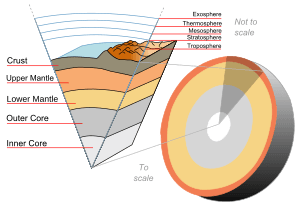Structure of the Earth facts for kids
The Earth is like a giant onion, made up of several different layers! These layers are unique, both in what they're made of and how they behave. From the outside in, our planet has a solid outer layer called the crust, a thick, gooey layer called the mantle, a liquid outer core, and a solid inner core right at the center. Even though it looks like a perfect ball, the Earth is actually a bit squashed at the top and bottom (the poles) and bulges out around the middle (the equator). Scientists call this shape an oblate spheroid.
We know about these hidden layers thanks to special tools called seismographs. These tools measure the vibrations that travel through the Earth during earthquakes. By watching how these vibrations bounce off different materials, scientists can figure out where one layer ends and another begins. One of the first big discoveries was the boundary between the crust and the mantle, which is called the moho.
Contents
Earth's Main Layers
Our planet has four main layers, each with its own special features.
The Crust
The crust is the very top layer of the Earth, where we live! It's made of solid rocks and is the thinnest layer. Think of it like the skin of an apple. The crust is mostly made of lighter elements like silicon, oxygen, and aluminium. Because of these elements, it's sometimes called sial (Si for silicon, Al for aluminium).
The Mantle
Right below the crust is the mantle. This layer is much thicker than the crust. It's mostly made of oxygen, silicon, and a heavier element called magnesium. This mix is sometimes called siam (Si for silicon, am for magnesium). Even though it's solid, the mantle is very hot and can flow very slowly, like super thick syrup over millions of years.
The mantle itself has different parts:
- The very top part of the mantle is solid and joins with the crust to form what we call the lithosphere. This is what the Earth's huge tectonic plates are made of.
- Below the lithosphere is the asthenosphere, which is a softer, semi-liquid part of the mantle where hot, melted rock (called magma) can be found. The lithosphere plates float on this softer layer.
- There are also lower parts of the asthenosphere and the lower mantle, which get hotter and denser as you go deeper.
The Core
At the very center of the Earth is the core. It's super hot, with temperatures between 5,000 and 6,000 degrees Celsius! The core is mostly made of iron and nickel.
- The outer core is a liquid layer that surrounds the inner core.
- The inner core is the very middle of the Earth. Even though it's incredibly hot, the pressure there is so immense that it squeezes the iron and nickel into a solid ball.
Scientists are still learning exactly how these layers interact and what causes some of the changes in the materials as you go deeper into the Earth.
The Moho Boundary
The moho (short for Mohorovičić discontinuity) is the important boundary line between the Earth's crust and the mantle. It was discovered in 1909 by a Croatian scientist named Andrija Mohorovičić. He noticed that when an earthquake happened, seismographs recorded two different types of waves. One wave traveled slower and stayed closer to the surface, while another, faster wave seemed to come from deeper inside the Earth. He realized that the deeper wave sped up because it entered a different, denser material – the mantle!
The moho is not at the same depth everywhere. Under the continents, it's usually about 30 to 40 kilometers (18 to 25 miles) deep. But under the ocean floors, it's much closer to the surface.
Trying to Drill to the Moho
Scientists have wanted to drill down to the moho for a long time to get samples of the mantle. In the 1950s and 60s, a project called Project Mohole tried to do this in the United States, but it was eventually stopped. The Soviet Union also tried, drilling the world's deepest hole to over 12,260 meters (40,223 feet) over 15 years, but they also had to stop.
Reaching the moho is still a big goal for scientists. One idea is to use a special capsule filled with radioactive material. This material would create enough heat to melt the rock around it, allowing the capsule to slowly sink down towards the mantle, pulled by gravity.
More recently, Japan's "Chikyū Hakken" (Earth Discovery) project is using a special drilling ship to try and drill through the thinner ocean crust. In 2012, their ship, Chikyu, set a new record by drilling over 2,111 meters (6,926 feet) below the seafloor to get rock samples.
Macquarie Island: A Peek at the Moho
There's a special place on Earth called Macquarie Island, near Tasmania, where you can actually see rocks that are thought to have come from the moho! This island is located where two huge oceanic plates (the Pacific Plate and the Indo-Australian Plate) are pushing together.
The island is made of a type of green rock called ophiolite. Scientists believe this rock formed deep down at the moho and was brought up to the surface by a mid-oceanic ridge (where new crust is formed). Now, because the two plates are crunching into each other, these deep rocks are being pushed up where we can see them. Macquarie Island is the only place on Earth where this is happening right now! Ophiolites are also found in many of the world's major mountain ranges, but those were brought up millions of years ago.
See also
In Spanish: Estructura de la Tierra para niños



